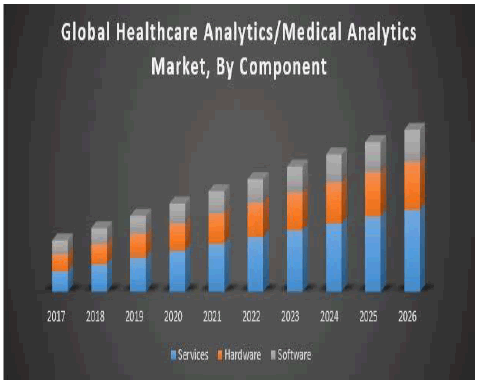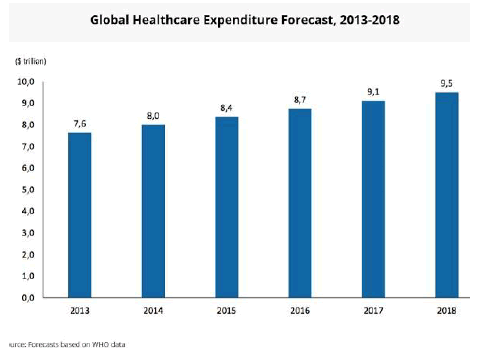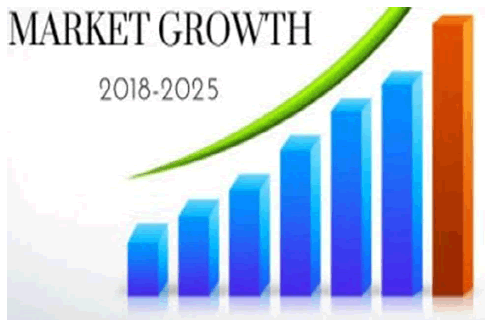Market Analysis - Journal of Nutrition and Human Health (2019) Volume 3, Issue 2
Market Analysis Report of the European Summit on Health and Fitness
Constantina LekakouProfessor, Department of Chemistry, University of Surrey, UK, E-mail: c.lekakou@surrey.ac.uk
The saying “What goes up, should return down” isn’t probably to use to the world health care sector in 2019. This vision might have a larger likelihood of turning into a reality if all stakeholders actively participate in shaping the future by manner of shifting focus off from a system of sick care within which we tend to treat patients when they fall unwell, to one of health care which supports well-being, prevention, and early intervention.
The global healthcare market size of Healthcare was valued at USD 305.78 billion and is expected to register a CAGR of 7.8% over the forecast period. Increasing cases of chronic diseases not to mention rise in geriatric population is anticipated to fuel the market growth. According an article by United Nations in 2017, elderly population accounted for nearly 13% of the global population and is anticipated to increase by 3% annually.

For instance, nearly 65% of Medicare beneficiaries reported to have more than one chronic condition and nearly 43% reported to have three or more chronic conditions. Rising workforce pertaining to healthcare service alters the increasing demand. As per statistics published by the U.S. Bureau of Labour Statistics, the ranks of personal care and home care aids are anticipated to reach 13.0 million by 2020, which translates to approximately 70.0% rise from 2010.
The global health care industry doesn’t show any signs of slowing down in 2019. Health care stakeholders troubled to manage clinical, operational, associated monetary challenges envision an trade within which new business and health care delivery models, power-assisted by digital technologies, might facilitate to unravel today’s issues and to make a property foundation for reasonable, accessible, high-quality health care. This vision may have greater probability of becoming a reality if all stakeholders actively participate in shaping the future by shifting focus away from a system of sick care to one of health care that supports well-being, prevention, and early intervention. the current state of the world health care trade and explores key trends and problems impacting care suppliers, governments, payers, patients, and different stakeholders.
As per The Healthcare Cost and Utilization Project, hospital stay is more expensive with average per stay cost which is being approximately USD 11,259. Home healthcare is cost-effective than hospital stays. According to the results of a study conducted at Brigham and Women’s Hospital (BWH) and Faulkner Hospital, the healthcare costs of home care were nearly 52% less than hospital stay costs for acute care patients. Therefore, the cost-effectiveness of home healthcare is expected to increase the market growth.
As the United States health care trade moves toward a monetary model that's supported price instead of volume, keeping folks healthy and out of the hospital are key. In a fee-for-service (FSS) model, health systems generate a lot of revenue once patient volume will increase. But under a value-based model, a person who shows up at an emergency room or a doctor’s office becomes an expense rather than a source of revenue. Rather than seeing folks as patients, health systems ought to treat them a lot of like members. This shift can help strengthen customer loyalty, build brand and reputation, and even improve the health of our nation.
The healthcare market is segmented by type into healthcare services, pharmaceutical drugs, medical equipment, biologics, and veterinary healthcare. Healthcare services were the most important phase of the care market, accounting for seventy-nine percentage. 4% of the total in 2018. It was followed by pharmaceutical medication, medical equipment and then the other segments. These are followed by care services and pharmaceutical medication wherever the markets are expected to grow at CAGRs of nine.3% and 6% respectively.

The world health care sector explores trends and problems impacting health care suppliers, governments, payers, patients, and other stakeholders. It conjointly outlines suggestions for them as they obtain to redefine the health care scheme and appears at examples from the market.
Diagnostics equipment was accounted for more than 38.0% of the overall market is expected to the rapid growth over the foreseeing years due to the increasing prevalence of cardiopulmonary diseases, diabetes and cardiovascular disease. Rising prevalence of chronic conditions requiring continuous monitoring, increasing awareness levels of patient and technological innovations and advancements, like Internet-of-Things (IoT), are expected to drive the demand over the upcoming years.
Rehabilitation services were the major services segment in 2018 and are estimated to expand further due to increasing geriatric population and cases of trauma-related surgeries. Infusion therapy is estimated to expand at a rapid pace during the forecast period on account of increasing demand for enteral and parenteral nutrition.
The health care services market consists of sales of care services and connected merchandise by entities that provide human healthcare services. This business includes institutions that offer services like medical and diagnostic laboratory services, dental services, medical care, residential habit and mental state facilities and alternative care services.
As the industry continues to move toward this value-based system, here are a few trends US health care organizations should watch in 2019: Collaboration between health systems and health plans, the shift to eudaemonia instead of health problem, however technology will facilitate place patients at the middle, enlarged adoption of virtual care choices, larger concentrate on population health.
North America held the largest revenue share of in 2018 due to the presence of sophisticated medical infrastructure and high patient awareness levels coupled with relatively higher health expenditure in the region. Supportive initiatives by the Centers for Medicare & Medicaid Services are anticipated to propel the market growth further.
Asia Pacific is anticipated to witness the maximum CAGR over the forecast period. Large geriatric population base, progressive economy, availability of skilled labour at economic costs, and large prevalence of chronic diseases are the key factors boosting the growth of this region.

The global marketplace for health care services is expected to grow at a CAGR of 9.3% to nearly $9,581.0 billion by 2022. Growth within the historic amount resulted from ascension within the size of senior populations, strong economic growth in emerging markets, health insurance reforms. Factors that negatively affected growth within the historic amount were low care access, and shortages of skilled human resources.
Event Details at http://fitnesshealth.alliedacademies.com/
-
European Summit on Health and Fitness
Barcelona, Spain